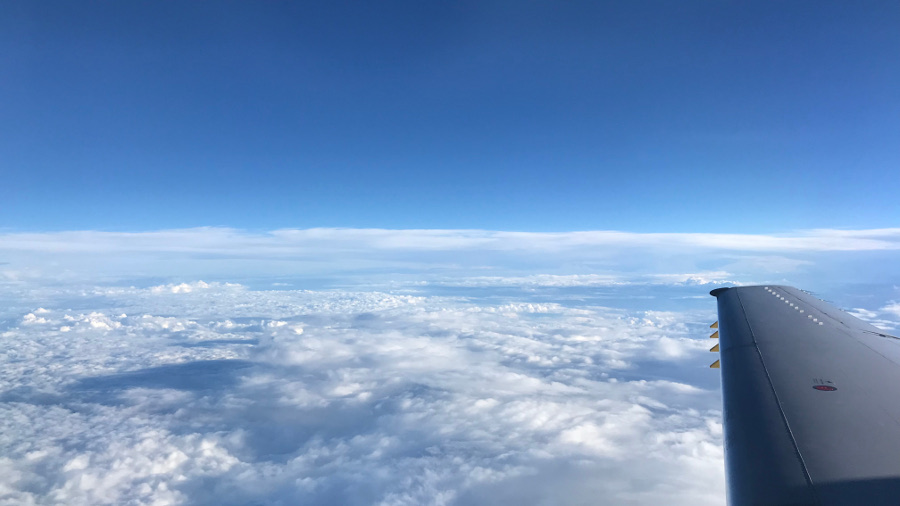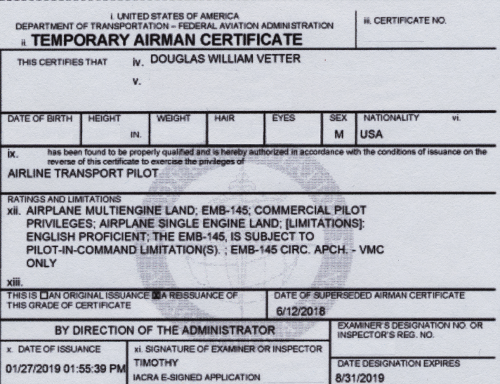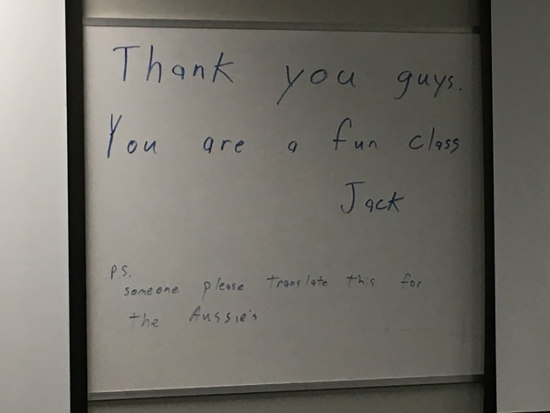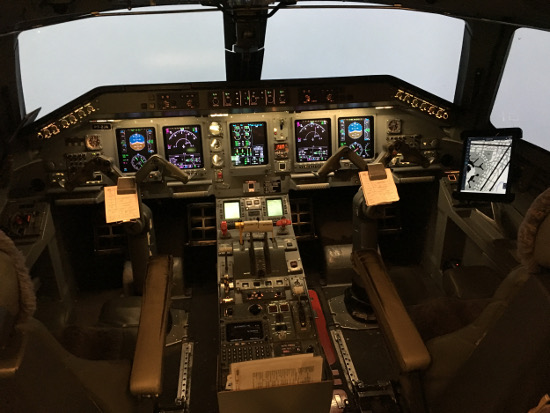My Journey To The Airlines
Page 4 of 4

An Embraer 145 LR in High Altitude Cruise
"That which does not destroy me makes me stronger"
My flight home was the low point in this process. Although I managed to engage in conversation with a very friendly and attractive (though unfortunately married) woman sitting next to me I couldn't help but just sit there and dwell on how I would bail myself out of this mess. I managed to get home, pack up all of my company's property and ship it back to them. With the divorce finalized I went back to my engineering work to get my mind off the unpleasant experience that had just unfolded.
A couple days later I decided to once again venture into the APC forums to update my research on the regional airline landscape. To make a long story short, I identified three companies I felt would be a good match, I applied to all three that afternoon and, as luck would have it, my first choice company called me at 9AM the following morning to set up an interview. The other companies eventually responded but by that time I had already passed the interview with the first company and made the decision to go there.
Lather, Rinse, Repeat
I would have been able to start at my new company in early November but I realized that my medical had just lapsed to a second class and they wouldn't accept anything but a first class so I had to take care of that. The huge perk for me was that indoc, systems, and SIT was scheduled at their base in Dulles, VA. That was less than a four hour drive so I took my new GTI to Dulles and avoided the expense of a rental car. Because I drove I was also able to bring more stuff from home that made my stay a lot more enjoyable.
I quickly noticed several differences from indoc at my former company. First, the class was literally half the size (14 vs 28). Second, the instructor didn't read many of the slides. He went around the room and made us read them. That kept the class engaged and asking important questions. Third, the instructor placed a lot of emphasis on preflight planning, deriving alternate minima, and the 17347 exemption that gives us relief from conditional statements in TAFs, whereas my former company's training glossed over these topics.
We also got our first crack at filling out a manual (paper) weight and balance form and spinning a whiz wheel as required to calculate the CG. I must admit that I rolled my eyes at this process and wondered "it's 2018 and we have iPads...why the hell isn't this an app?" However, the instructors told us that it's typically a backup in the event ACARS fails or is otherwise unavailable and we were unlikely to do a manual weight and balance unless we flew to the one destination in our route network that lacked ACARS. Oddly enough, a few weeks after we completed indoc my former company experienced a systemic failure that prevented them from using ACARS, and because they did not include manual weight and balance procedures in their training the entire airline was grounded for the duration. Ooops. Maybe the low-tech approach has its place in training after all.
By the end of indoc I realized that although most in the class were first officers we were being trained to make command decisions as our upgrade time was as quick as we could get 950 hours. That was in contrast to my former company which more clearly segregated the responsibilities between captain and first officer and hence the knowledge requirements of their first officers. I definitely preferred my new company's approach as it made me feel more confident and competent to serve as a crewmember, equal to the Captain in knowledge, if not responsibility.
Systems was about the same in terms of structure and intent of the course though in stark contrast with my former company we were kept on site at the training center for a full three weeks to complete the class. No CBT aside from the FMS trainers were used. Another notable difference was that our instructor was more informal, and like our indoc instructor, a lot less politically correct. He kept us laughing and really seemed to enjoy teaching and getting to know us, as well as the six crazy foreigners we let into the country to train with us. This resulted in some great bonding in the class. It felt a lot like I'd gone back to college and was hanging out with buddies in the dorm. In short, I found myself a lot more relaxed and "at home" at my new company.
Another Oral
At the end of systems and SIT I took a mock oral with the instructor. This amounted to about 90 minutes of Q&A, during which the instructor evaluated whether I was ready to be signed off. Fortunately I managed to impress him enough to put his John Hancock in my training folder. As a result, my oral wound up being scheduled a couple days later, on a Sunday morning. This was great as it gave me time to relax a bit and study just a bit more.
The oral at my former company was 90% about the airplane's systems and conducted solo with the APD. This oral, in contrast, was only about 20% systems. The remainder emphasized the preflight decision making process. Can we accept the aircraft? Are there any MELs/CDLs? How will they affect the flight? How about the release? Do we need alternate(s)? Are the alternate(s) provided on the release valid given the forecast weather?
I was able to take the oral with another guy from my class because we already had our ATPs and I found this format to be more educational and a lot less intimidating. Although we had to do our own weight and balance and performance numbers, the APD ping-ponged questions between the two of us. The oral was a full five hours, but subtracting the chatting and paperwork it was probably closer to four and a half hours.
At the end I couldn't help but tell the APD (who coincidentally had been at the company 18 years and was #8 in the seniority list) that I felt the scope of the oral was very thorough as compared to my former company, which seemed to obsess about systems. He said that the training was designed this way not only because they expect FOs to become Captains relatively quickly but also so everyone in the training department can sleep at night knowing they are minting qualified crewmembers.
Simulators, Take 2
After the oral we were given the option to begin simulator training immediately in HOU or wait about 10 days and start in CVG. I elected to wait and go to CVG because I knew I could drive there once again and save the cost of a rental car.
At my former company I remember walking down the drawbridge of the sim every night with a palpable fear of what lay ahead. A lot of this had to do with being tired and knowing that my performance might not meet my own expectations, not to mention the company's completion standards. However, my experience at my new company could not have been more different. Not only did I not fear GFS or simulator sessions -- I looked forward to every one. Being awake, alert, and in a rational state of mind definitely helped here, but so did our instructors. Due to a fluke of scheduling we had our awesome systems ground instructor for one of the GFS lessons and as expected, he was a breath of fresh air. Not only did we joke around a lot, which cut the tension, he gave us lots of tips based on his line experience and as a result we had a very productive lesson and got ahead of the pack. We had another great instructor for the first four sim lessons who slowly and skillfully built us up from day one to the point that we used our first "additional" session for the next lesson in the series. This continued until we had completed lesson 10 with three sessions to go, which we then used for checkride prep and, ultimately, the mock checkride.
On our mock checkride I flew first and performed well, including what had to be my best V1 cut since I started training. I stopped the yaw while on the roll, locked the rudder in place to elminate any chance of PIO, added just the right amount of rudder as the nosewheel came off the ground, rotated smoothly and consistently at the ideal rate, and climbed out exactly on profile, remembering all of my callouts. Normally instructors wait until the debrief to give critiques but he interjected at this point, saying "that was an absolutely perfect V1 cut, Doug! Well done!"
I concluded the session by conducting a perfect crosshairs approach with airspeed held within 1 knot, landing single engine precisely on the centerline in a good crosswind. As the aircraft came to a stop the instructor again complemented me on my stick and rudder skill, adding "you know why I kept asking you whether the autopilot was on? I honestly couldn't tell back here." Apparently, students typically throw the rudder all over the place during single engine operations and to simulate the yaw rate the motion base throws the sim around an axis that makes the instructor move around a lot more. The autopilot naturally locks down the rudders and prevents that yaw rate but as I had elected to fly all my single engine work without the autopilot I had no such assistance. Since I learned to lock my rudder to the thrust lever, so to speak, and generally be as smooth as possible the sim didn't have to generate those yawing moments to the same degree.
My sim partner then repeated the scenario. While he did his airwork I looked back at the instructor and said "hey, I think we have to call the sim techs because my instruments are frozen!" This of course was a compliment to my sim partner's awesome stick and rudder skills while cranked over in a 45 degree bank. We wrapped up the session with an emergency evacuation exercise due to an APU fire that we confirmed with tower was producing visible smoke and flames. As the batteries were turned off at the very end of the checklist the instructor turned to us and said "very nice work guys...you're one of the best prepared crews I've seen come through here." He then gave us the best compliment an instructor can give at this point in training: "When my family is flying on our metal I want you guys up front".
The Checkride
Despite the fact that my crew partner and I were quite satisfied with our performance on the mock checkride I will admit to being appropriately nervous prior to the real checkride. This was a far cry from the extreme nervousness and lethargy I felt prior to the checkride at my former company, however. The difference, of course, was that I had a confidence in my ability that only comes from being trained to proficiency.
Although the examiner threw us a few curve balls by doing things just a bit differently than we expected we knew going in that this guy liked to change things up. What saved us was the fact that my sim partner and I got along well and had developed good CRM and critical thinking skills. We followed the checklists religiously, analyzed each unscripted situation carefully before taking action, and made sure we had communicated the plan with everyone including ATC, dispatch, cabin crew and each other. This kept the airplane flying safely even when batteries were frying, flaps were failing, engines were trailing smoke and flames, or rouge airport vehicles were taxiing onto the runway as we descended to 100 feet above the touchdown zone, causing us to execute a go-around at the last second.

After I finished my portion of the flight I heard the examiner say, rather simply, "okay, that's satisfactory", which is APD speak for "you passed". After we shut down and headed back to the debriefing room one of the instructors we'd had on an earlier lesson saw me and asked "Well? How'd it go?" I smiled, held a thumbs up and said "I've redeemed myself!" Later during the debrief I related to my sim partner that although I hated failing earlier I'm glad the industry held the standard, because if you give everyone a gold star for showing up then achievement means nothing. He agreed.
Closure
At one point earlier in sim training I was in the break room chatting with my sim partner prior to a lesson when in walked the instructor from my former company who signed me off for the recheck. I knew the company did recurrent training at this facility so I figured there was a good chance I might see some familiar faces there but I didn't expect to see this particular guy. He immediately recognized me, came over to say hi, and we chatted a bit. He said he was glad to see I'd landed on my feet and then suggested my move to the new company was a step up as he smiled and said "well, now you have something I don't -- the CPP", a reference to United's Career Path Program -- essentially a prescreening process for possible hiring at United mainline. I said "yea, assuming I pass training, the Hogan, and the interview at United, sure...I may wind up there in a few years, but we'll see".
After we wrapped up the conversation I assumed this would be the last time I'd see any of my old instructors. And it was...until a couple days later when I passed the guy in the hall who did my mock checkride and signed me off for the original check. Mind you these were the only instructors from my former company I saw there and my mind is still trying to wrap itself around the probability of running into those two guys at the same place and time. I won't propose the ludicrous idea that this was part of some grand plan but the end result was the same. I got a chance to bring some closure to what happened there and let both instructors know there were no hard feelings.
Final Thoughts and Summary of Advice
If you are thinking of going to a regional airline you'll figure out pretty quickly that there are a lot of often conflicting criteria to consider when selecting a company. While living in base (i.e. within reasonable driving distance) is probably the most important to quality of life once you're on the line, the most important factor with respect to your success in training is the quality of the training department and the willingness of the company to provide additional training as required. This is particularly true if this is your first 121 job and/or type rating, as good instruction (or the lack of same) can make or break you and failures will follow you for the remainder of your career.
Since studying is a huge part of the training process I'll point out that with minor exceptions I studied alone. This is mostly because, as an engineer, I am very used to doing this. The reason I point this out is that you'll probably get a lot of peer pressure to work in a study group. I've heard some training departments even strongly advocate group study. If in doubt as to whether group study is right for you, try it, but be aware that even if you are a CFI you are not an instructor in this context, and if you wind up carrying the group while ignoring your own weaknesses you put your own success in jeopardy. Put another way, always try to help others, but don't forget to help yourself. I aced all of my written exams at both companies so studying alone clearly worked for me. Your mileage may vary.
If you've never been in a Part 121 training environment, here's my advice:
-
Take training seriously. This is your career and failures have serious long term consequences.
-
Be aware that, possibly for the first time, you're not the customer -- your employer is. They are expecting you to bring a certain degree of skill, talent, and experience to the training center. Airline training is very much a meritocracy. If you expect to show up and be spoon fed, things aren't going to turn out the way you expect.
-
Make sure you are proficient in IFR procedures and basic hand flying because airlines do not teach you to fly IFR. If you don't have these skills down cold you will devote critical time and mental resources away from what they are trying to teach you -- how to fly that particular type of airplane.
-
Avoid distractions. That includes family. Years ago I took a company-required engineering management course. To be honest the class was mostly a yawn-fest but I did take away one phrase intended to make us more effective: "Be here now". Loosely translated, this means prioritize the task at hand and deal with all the non-relevant tasks later. If you try to do everything at once you'll suck at everything you try to do.
-
Exercise, if even for only a half hour every couple of days, to reduce physical stress. I did not exercise at all during training at my former company but the second time around I wound up using the hotel's facilities every second or third night. I got great sleep as a result and the endorphines relaxed me during the sessions the following morning.
-
If you're not in class or eating/exercising, study, but only to a point. Do not sacrifice good sleep to study. That will backfire in short order.
-
Eat good food including fruits, nuts, and salads. Avoid junk food and fast food. This is good advice in general but is particularly important during training, as good food will help you maintain your immune system and keep you healthy during a stressful time.
-
Get at least 8 hours of sound sleep every night. If you have a tendency to lose track of time, use the iOS "Bedtime"feature (or an Android equivalent) to remind you when to go to bed to get required sleep.
-
Don't drink alcohol, especially with dinner, as it dulls the senses and disrupts sleep.
-
Lastly, but perhaps most importantly, complain if the company assigns you a consistently bad simulator or GFS schedule. That's not to say you shouldn't be prepared to do your share of late night sessions but if every session has you flying at oh-dark-thirty you need to speak up or risk a training failure due to fatigue. Don't repeat my mistake.
Questions / comments?
If you have any questions or comments about this article feel free to contact me. If you really liked this article and it provided something of value to you, please consider a small donation to my site support fund. Thanks in advance!





